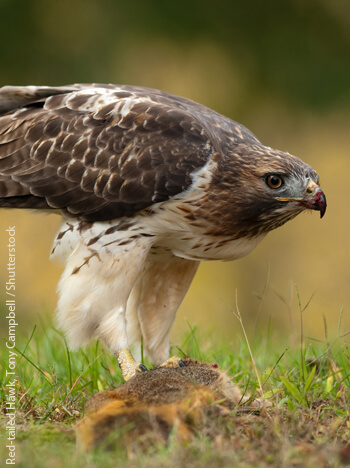Hunting Seasons Starting Soon: Hunters Urged to Stock up on Non-Lead Bullets/Shot
 |
| Red-tailed Hawks are some of the many birds that can be poisoned and killed by lead ammunition used in hunting. This problem is easily solved by switching to non-lead alternatives. |
(Washington, D.C., September 11, 2014) American Bird Conservancy (ABC), a leading bird conservation organization, today urged hunters who are beginning to plan for the many different fall and winter hunting seasons—some of which start in September—to protect the environment and non-target wildlife by voluntarily switching to non-lead ammunition.
“Hunters have historically strong outdoor ethics, and as more and more of them are learning how lead bullet fragments left in gut piles or lead shot scattered on the ground can poison and kill scores of animals—including Bald Eagles, California Condors, hawks, ravens, and others–they are voluntarily switching in ever-greater numbers to readily available, lead-free alternatives,” said George Fenwick, President of American Bird Conservancy.
ABC is encouraging the hunting community to switch from traditional lead-based ammunition in favor of non-lead alternatives because millions of birds are poisoned every year following ingestion of either shotgun pellets mistaken for grit or seeds, or lead particles left in gut piles following hunts. Among the birds most impacted are Bald Eagles, hawks, vultures, California Condors, and Mourning Doves.
According to Ed Clark, President and Co-founder of the Wildlife Center of Virginia, one of the nation's premier wildlife rehabilitation facilities, “There is an overwhelming amount of evidence that shards of lead from spent bullets can kill non-target wildlife when it is available to scavengers. As many as 60 percent of all Bald Eagles admitted to the Wildlife Center are suffering from lead toxicosis as their primary or secondary problem. We often recover lead shot and fragments of lead core bullets.”
“This is not a new problem,” Clark continued. “It is just that the technology to easily identify the problem has only been available in the last few years. The question is not whether or not lead is causing the deaths of eagles and other wild animals; the real question is, what are we going to do about it? Hopefully education will move us in the right direction, but if that doesn't work, regulations are just over the horizon.”
Non-lead ammunition can be more expensive, but claims by some that this is prohibitive for hunters have been shown to be vastly overstated. For example, the cost of most premium lead and non-lead ammunition is now about the same according to Cabelas, one of America's leading outdoor outfitters. According to user reviews on the company's website, many hunters are so satisfied with the performance of the non-lead ammunition that they say they will never go back to the old lead versions.
Fenwick and Clark agree on several fundamental actions that can be taken by many to reduce the lead poisoning problem: increased voluntary use of non-lead ammunition; proper disposal of carcasses shot with lead ammunition; and the continuation and even escalation of education programs to the hunting community on the lead poisoning issue.
“Some lead-free ammunition still costs more, but we can expect the price to continue to come down as production increases to cope with higher demand. And when taken as a total percentage of the cost of going hunting—which includes permits, gas, sometimes lodging, and other supplies—the extra cost of non-toxic ammunition is very manageable,” said Fenwick.
Increasing demand for non-lead shot following a 1991 ban on using lead shot for waterfowl hunting has caused the price to drop to levels comparable to that of lead shot. The lead ban was implemented U.S.-wide by the federal government and was prompted by studies that found that lead shot was poisoning and decimating waterfowl populations.
(Note to editors: One way to determine hunting season start dates in your state is to insert into your browser search feature the name of your state followed by the words “hunting season dates.” This pulls up numerous sites that provide that information.)


















































